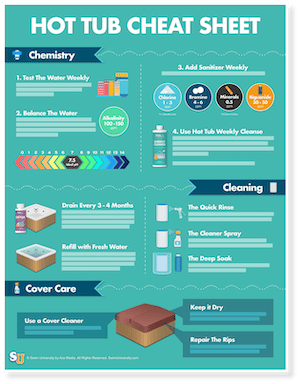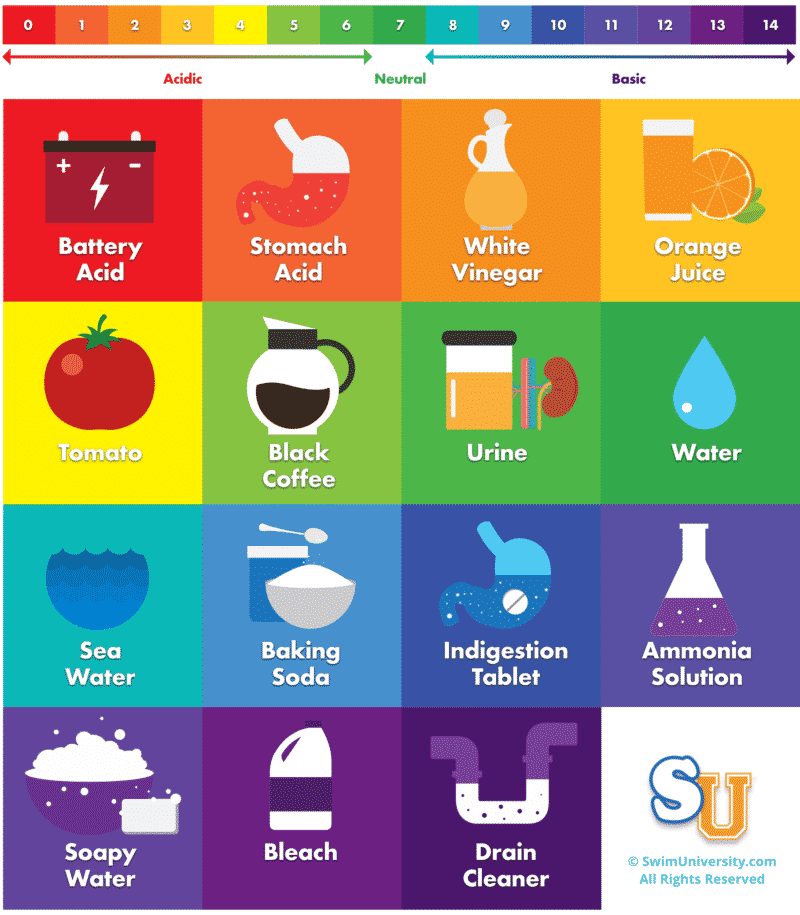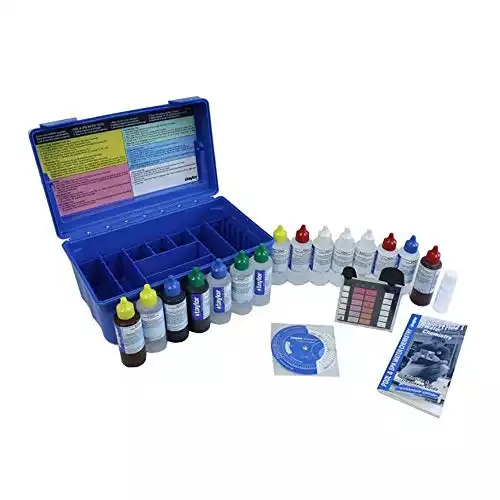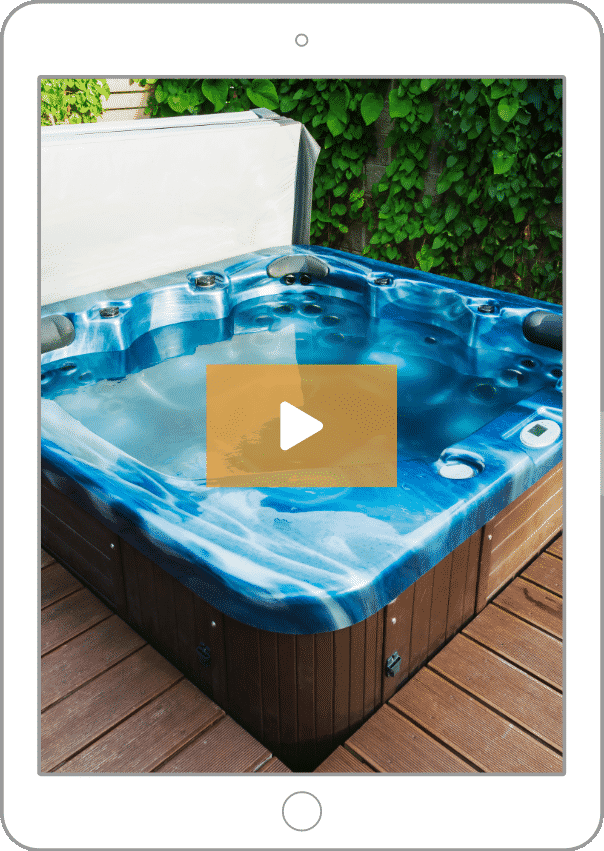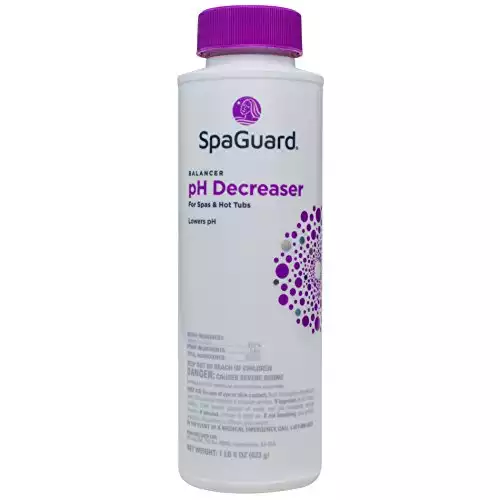If the alkalinity in your hot tub is high, it can cause green water because it reduces the effectiveness of your sanitizer (chlorine, bromine, etc.). So to lower alkalinity in your hot tub, add pH Decreaser or soda ash (sodium bisulfate).
But why is your alkalinity high in the first place? Let’s start there and solve the problem from the beginning.
What is Alkalinity?
What’s the difference between pH and alkalinity? First, we have to understand that pH is the measurement of how acidic or basic your hot tub water is. Here’s an image to illustrate the pH scale.
Our goal is to keep the pH balanced between 7.4 and 7.6. Not too acidic and not too basic.
Alkalinity, on the other hand, is the capacity of water to resist acidification (thanks Wikipedia!). But we like to think of alkalinity as pH’s bodyguard.
Hot tub pH is volatile. Any little thing that interacts with your water can drastically change the pH. But when you have the right amount of alkalinity, this will take the hit before drastically affecting your pH.
So without alkalinity, the pH reading would be all over the place. Alkalinity and pH are related, but they are not the same.
Unlike pH, alkalinity is measured in parts per million or ppm for short. Most resources tell you to keep it between 80-120 ppm. However, we recommend keeping your hot tub alkalinity between 100-150 ppm to give yourself more room. We have an article all about hot tub water chemistry if you’re interested in learning more.
A simple but effective liquid test kit for chlorine pools and hot tubs.
What Causes High Alkalinity in a Hot Tub?
To be fair, high alkalinity is not a common issue in hot tubs. Mainly because most owners drain and clean their hot tub every 3-4 months to keep things from building up.
That said, there are a few main causes of high alkalinity in a hot tub:
- Too Many Chemicals: You could be adding too many chemicals to your hot tub which can increase your Total Dissolved Solids or TDS. Drain and clean your hot tub every 3-4 months to avoid this issue.
- Sweat, Lotions, and Other Gross Body Stuff: YOU or your family and friends could be raising the pH with all your body lotions, sunblocks, perfumes, hair gel, etc. Shower before you soak!
- Your Water Source: You may live in an area where your local water supplier has a high alkalinity reading. Ask your township or county or local water district for a water reading. Most places will provide one.
- Human Error: You could have accidentally had a heavy hand in adding alkalinity increaser or baking soda. Whoops!
Tired of trying to keep your hot tub clean all the time and dealing with chemicals?
You'll save $100 right away with this easy-to-follow digital ebook and video course. This is the ultimate maintenance guide that hot tub manufacturer doesn’t provide you.
Click Here to Learn MoreWhat Happens if Alkalinity is Too High in Hot Tub?
The main thing that can happen is it renders your sanitizer (chlorine, bromine, etc.) useless. And that can cause your water to turn green and bacteria to grow making the hot tub unsafe to soak in. Secondly, it can cause a scale build-up which will make your hot tut work twice as hard to heat up.
All of this puts hot tub soakers at risk for skin issues like hot tub folliculitis. Plus, it puts you (the hot tub owner) at risk for empty wallet syndrome by replacing heaters and adding more sanitizing chemicals.
How Do I Lower The Alkalinity in My Hot Tub?
The easiest way to lower alkalinity in your hot tub is by adding a pH Decreaser (sodium bisulfate). I know this is confusing because pH and alkalinity are not the same. But it works!
Before you add pH Decreaser to your hot tub, you need to know how much water your hot tub holds. Then, you can follow these steps:
- Test the hot tub water. Use a liquid test kit (recommended) or a test strip to find out the current alkalinity reading in your hot tub and if you even need to lower it.
- Add pH Decreaser (sodium bisulfate). For example, if your hot tub has 1,000 gallons of water, use about 3 ounces (85 grams) to lower the alkalinity by 10 ppm. Sprinkle (or “broadcast”) the powder around the surface of your hot tub while it’s running to help it mix in.
- Retest the water. After 24 hours, test the water again and readjust if needed.
What Should Be Adjusted First Alkalinity or pH?
Alkalinity Increaser or baking soda (sodium bicarbonate) will also increase pH. If both readings are low, start with increasing alkalinity first. Then, test the water again. If the pH is still low, but the alkalinity is good, then just add pH increaser or soda ash (sodium carbonate).
It depends on what your current readings are. So it’s important to always test your hot tub water before adding any chemicals to make adjustments. Here’s some more information on balancing pH in a hot tub.
Does Vinegar Lower Alkalinity in a Hot Tub?
No. White vinegar (or any other type of vinegar) does not lower alkalinity. It will only, only lower the pH in your hot tub.
Final Tips to Control Hot Tub Alkalinity
Hopefully, that answered a lot of your questions about lowering hot tub alkalinity and how to prevent it from being so high in the first place. Here are a few more tips for dealing with both pH and alkalinity:
- After adding any chemicals to your hot tub, allow your water to circulate for at least 15 minutes before retesting. Or better yet, retest the next day for more accurate readings.
- You can keep Alkalinity between 80-120 ppm, but we recommend 100-150 ppm to give the alkalinity more room to come down before having to adjust again.
- For the most accurate water test, collect a water sample into a clean cup, and test it after it has cooled to room temperature. And use a liquid test kit because they’re more accurate than test strips.
- Never mix chemicals together. Add them one at a time and at least 15 minutes apart with the cover off.
- Change your spa water at least every 3 to 4 months. And more often is you use your hot tub a lot.
Happy Swimming!

Recommended Guides
Keeping tabs on your hot tub water is easy and the best thing you can do to head off problems. Just keep some spa test strips on hand, and you're set.
Looking for how to raise the pH in your hot tub? Or maybe how to lower the pH in your hot tub? Well, look no further. It's all right here.
Do you know which hot tub chemicals you need to keep the water balanced? What about when and how to add them? Get a hot tub chemistry education right here.
Don’t know how many gallons of water are in your hot tub? How can you know whether you’re adding enough sanitizer? Don’t guess. Get the data you need.
